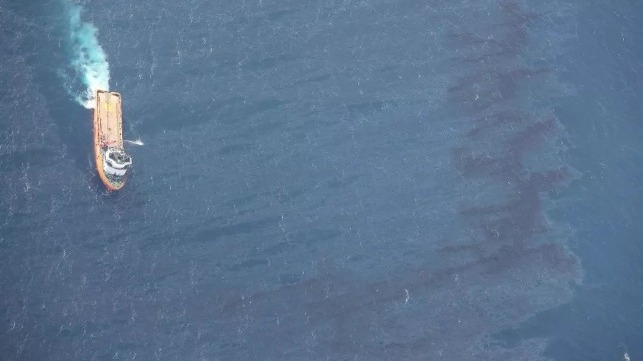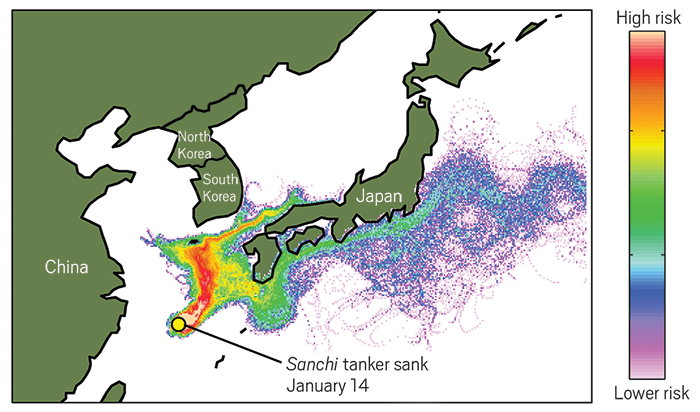Sanchi's Wreck May Be Leaking Bunker Fuel

China's State Oceanic Administration said Friday that the surface slick above the wreck of the tanker Sanchi may indicate that she is leaking bunker fuel. Her heavy bunkers will persist in the marine environment for longer than her cargo of ultra-light natural gas condensate, experts warned.
The 40-square-mile spill's shape has changed and now takes the form of four separate slicks. While it may inflict environmental damage on marine life in the East China Sea, the petroleum is not expected to reach shore in significant quantities.

Red areas indicate likeliest concentration of spilled cargo over time (University of Southampton National Oceanography Centre)
The Chinese spill response team will deploy an ROV to investigate the state of the Sanchi's wreckage. The wreck site is shallow enough for technical diving, and salvors may be able to reduce the extent of the spill by pumping out Sanchi's tanks, depending on conditions at the bottom. Experts have estimated that she had 1,000 tonnes of fuel on board at the time of the sinking, though the exact amount is unknown.
"The residual oil [HFO] would be a main problem. Compared to spilled oil on the surface, which could be cleaned easily, the residual oil in the sunken tanker will continue to spill under the sea. That's why salvage operations are important," said Ma Jun, director of China's Institute of Public and Environmental Affairs, speaking to the Global Times on Friday.
China details fire response efforts
The raging fire and repeated explosions aboard the Sanchi were unlike anything Chinese response agencies have had to face before, the nation's Ministry of Transport said Friday.
"As there were no similar incidents in history, we have no rescue practice or experience to follow, posing huge difficulties for the rescue . . . but saving people's lives is our top priority," said ministry official Zhi Guanglu, speaking to reporters in Beijing. "In the process of the rescue, our ships and sailors were constantly in danger."
Zhi detailed the unique problems SAR crews faced during the firefighting effort. The Sanchi's position was about 20 hours of steaming time from shore for the response boats, and the attempt to put out the burning condensate required the responders to constantly replenish their supply of firefighting foam. The fire also put out clouds of toxic gas, forcing rescue vessels to keep their distance. In addition, the heat was severe enough to strip off Sanchi's topside paint from stem to stern, and temperatures approached 200 degrees in her wheelhouse on the relatively calm day that salvors boarded to attempt a rescue.
The leader of that salvage boarding party, Xu Junlin, told CGTN on Friday that his team members were not sure that they would return alive. "We took a group photo before we went,” he said. “We all had the thought that if we did not return, we should at least leave a final glimpse of us for our families.”
The boarding team survived, but Sanchi's crew did not return alive. The bodies of three out of her 32 crewmembers have been found, and the head of Iran's Ports and Maritime Organization, Mohammad Rastad, said Sunday that the remaining 29 individuals are considered deceased.
Zhi said that the spill response and salvage effort will remain hazardous, especially in the event that authorities attempt to raise Sanchi back to the surface. He suggested that removing the wreck from the bottom was the "best solution" under consideration, though he admitted that it was also an "extremely daunting" option. The spill burned for some time after Sanchi's sinking, and he indicated that another release of the volatile, flammable cargo from the wreck during salvage could lead to another fire.
The joint Chinese and Iranian investigation into the cause of the accident is under way. The salvage team retrieved the Sanchi's charred VDR unit before she sank, and investigators are now examining its contents to learn more about the circumstances leading up to her collision with the freighter CF Crystal. At this point the cause of the accident is unknown.
